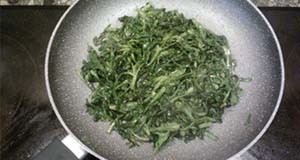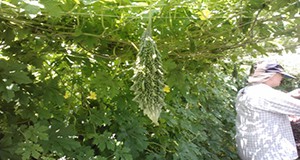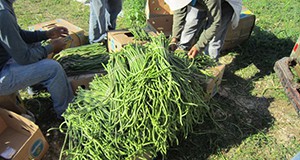
Tong Hao (Glebionis coronaria) is a member of the daisy family and therefore a relative of lettuce. It is an important vegetable in Asian communities. Grown in China for more than 900 years, Tong Hao is a branched annual leafy herb that can be cooked and eaten. This four-page fact sheet provides background information about Tong Hao, including information on growing, harvesting, and cooking it. Written by Guodong Liu, Qingren Wang, Bonnie Wells, Yuncong Li, and David Dinkins, and published by the Horticultural Sciences Department.
http://edis.ifas.ufl.edu/hs1276
Tag: Bonnie Wells
Bitter Melon: An Asian Vegetable Emerging in Florida
 Bitter melon is a tropical and subtropical vegetable crop with long climbing vines which is widely cultivated in Asia, Africa, and the Caribbean. The unripe fruit is used as a vegetable with a pleasantly bitter taste. This 7-page fact sheet provides an overview of this plant as well as recommendations for individuals in Florida who are interested in growing it. Written by Guodong Liu, Qingren Wang, Yuncong Li, David Dinkins, Bonnie Wells, and Yuqi Cui, and published by the UF Department of Horticultural Sciences, December 2015.
Bitter melon is a tropical and subtropical vegetable crop with long climbing vines which is widely cultivated in Asia, Africa, and the Caribbean. The unripe fruit is used as a vegetable with a pleasantly bitter taste. This 7-page fact sheet provides an overview of this plant as well as recommendations for individuals in Florida who are interested in growing it. Written by Guodong Liu, Qingren Wang, Yuncong Li, David Dinkins, Bonnie Wells, and Yuqi Cui, and published by the UF Department of Horticultural Sciences, December 2015.
http://edis.ifas.ufl.edu/hs1271
Long Squash: An Asian Vegetable Emerging in Florida
 Long squash is an annual, vigorous, and herbaceous crop that was brought to the Americas by Paleoindian populations from Asia before the arrival of Columbus. This 4-page fact sheet provides an overview of this plant as well as recommendations for individuals in Florida who are interested in growing it. Written by Guodong Liu, Yuncong Li, David Dinkins, Bonnie Wells, Qingren Wang, and Yuqi Cui, and published by the UF Department of Horticultural Sciences, December 2015.
Long squash is an annual, vigorous, and herbaceous crop that was brought to the Americas by Paleoindian populations from Asia before the arrival of Columbus. This 4-page fact sheet provides an overview of this plant as well as recommendations for individuals in Florida who are interested in growing it. Written by Guodong Liu, Yuncong Li, David Dinkins, Bonnie Wells, Qingren Wang, and Yuqi Cui, and published by the UF Department of Horticultural Sciences, December 2015.
http://edis.ifas.ufl.edu/hs1272
Long Bean: An Asian Vegetable Emerging in Florida
 Food diversity, nutritional food supply, and profitability are the priorities of agricultural and horticultural industries. To diversify vegetable products and increase the Florida vegetable industry's competitiveness, a number of new vegetable crops are rapidly emerging in the state. Due to Florida's favorable climate, these vegetable crops grow well and have high market potential. The objective of this 6-page fact sheet is to provide a general overview of long bean, one of the Asian vegetable crops grown in Florida. Written by Kshitij Khatri, Guodong Liu, Qingren Wang, Yuncong Li, David Dinkins, and Bonnie Wells, and published by the UF Department of Horticultural Sciences, October 2015.
Food diversity, nutritional food supply, and profitability are the priorities of agricultural and horticultural industries. To diversify vegetable products and increase the Florida vegetable industry's competitiveness, a number of new vegetable crops are rapidly emerging in the state. Due to Florida's favorable climate, these vegetable crops grow well and have high market potential. The objective of this 6-page fact sheet is to provide a general overview of long bean, one of the Asian vegetable crops grown in Florida. Written by Kshitij Khatri, Guodong Liu, Qingren Wang, Yuncong Li, David Dinkins, and Bonnie Wells, and published by the UF Department of Horticultural Sciences, October 2015.
http://edis.ifas.ufl.edu/hs1268
Palm Aphid Cerataphis brasiliensis (Hempel) (Insecta: Hemiptera: Aphidae: Hormaphidinae) (EENY520/IN924)
 The palm aphids are the only aphids known to infest palm plants. High populations occasionally become severe in nurseries and the landscape, and can cause substantial damage to young coconut palms. They pierce palm foliage and suck out the plant phloem content, causing yellowing of the tissues and loss of plant vigor. In addition, honeydew production by the aphids promotes sooty mold growth that can limit photosynthesis. Palms heavily infested with aphids can experience stunted growth. This 4-page fact sheet was written by Bonnie C. Wells and published by the UF Department of Entomology and Nematology, March 2012.
The palm aphids are the only aphids known to infest palm plants. High populations occasionally become severe in nurseries and the landscape, and can cause substantial damage to young coconut palms. They pierce palm foliage and suck out the plant phloem content, causing yellowing of the tissues and loss of plant vigor. In addition, honeydew production by the aphids promotes sooty mold growth that can limit photosynthesis. Palms heavily infested with aphids can experience stunted growth. This 4-page fact sheet was written by Bonnie C. Wells and published by the UF Department of Entomology and Nematology, March 2012.
http://edis.ifas.ufl.edu/in924
Refillable Containers and Secondary Containment Requirements for Agricultural Pesticides in Florida (PI240)
 This 4-page fact sheet discusses the requirements for selection and design of containers and dispensing areas,as well as operation, inspection, maintenance and recordkeeping. Written by Bonnie Wells and F.M. Fishel and published by the UF Department of Agronomy, January 2012.
This 4-page fact sheet discusses the requirements for selection and design of containers and dispensing areas,as well as operation, inspection, maintenance and recordkeeping. Written by Bonnie Wells and F.M. Fishel and published by the UF Department of Agronomy, January 2012.
http://edis.ifas.ufl.edu/pi240
Rainfastness of Pesticides (PI238)
 Generally, it is best to avoid pesticide application when rainfall is likely; however, weather can be unpredictable, so it is best to choose a product with good rainfast characteristics. Learn more in this 3-page fact sheet written by Bonnie Wells and F.M. Fishel, and published by the UF Department of Agronomy, August 2011.
Generally, it is best to avoid pesticide application when rainfall is likely; however, weather can be unpredictable, so it is best to choose a product with good rainfast characteristics. Learn more in this 3-page fact sheet written by Bonnie Wells and F.M. Fishel, and published by the UF Department of Agronomy, August 2011.
http://edis.ifas.ufl.edu/pi238
Agricultural Pesticide Use in Florida: A Summary, 2007-2009 (PI235)
Commercial farms in Florida span over nine million acres and earn annual profits of more than $7.5 billion. High temperatures and heavy rainfall create heavy pest pressure that leads the majority of Florida farmers to rely upon pesticides for high-yielding, cost-effective crop production. This 4-page fact sheet lists top ten pesticides and the crops associated with this use, and also specifies the most common fungicides, insecticides, herbicides, and other pesticides.Written by Bonnie Wells and F.M. Fishel, and published by the UF Department of Agronomy, June 2011.
http://edis.ifas.ufl.edu/pi235